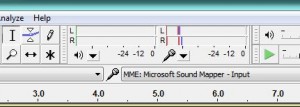LPs or long playing records have been around for decades, probably over 60 years. Records themselves date back to the ’20s I guess, maybe even prior to that. The really old ones were 78s and very low fidelity. 78 means that the records spun around at 78 revolutions per minute. The later version, the LPS, spin at 33 1/3 RPM and can be considered high fidelity. Even though most artists release their material on CDs now, we still say that they are releasing a record as opposed to CD. Some very cool artists are releasing their material on LPs as well as on CDs. A tour through any upscale stereo shop will include at least a few turntables on display. Last week I saw a magnificent $13,000 turntable at Bay Bloor Audio here in Toronto.
Playing an LP is a bit cumbersome, seeing as how you have to have the turntable, an amp and speakers. Since you can’t take your LP music out for a walk or a drive, most of us are recording our LPs to our computers, converting them from analog to digital using Audacity. Here’s how I do it.
Download Audacity and install it. Audacity is free, part of the open-source community. Audacity is available from Source Forge here: http://audacity.sourceforge.net/ . Once you have it installed, download the MP3 encoder here: http://lame.sourceforge.net/ . The lame encoder is necessary to encode your Audacity files into MP3s. If you don’t plan on using MP3s , then it’s not necessary.
Next you need a turntable. There are all kinds of them out there, some use USB ports to get the sound from the TT(turntable) to the computer but I prefer a direct-drive Panasonic or similar unit. The USB ones are fine for a few LPs as long as you don’t really care about quality too much. Now there are some very good USB TTs but you’d have to spend a bunch of cash to get one. My Panasonic came from the local Goodwill store and cost me ten bucks. I had to change the plug end of the cord from a European prong thingy to a North American two prong plug but that was pretty easy. There are two types of older TTs; direct drive and belt drive. Direct drive means that the motor is directly connected to the platter (the flat thing that the records sit on) while belt drive units have a system of pulleys and a belt that goes all the way around the platter, using friction alone to turn it. Obviously, the belts wear out and stretch over the years. You get speed variations, known as wow and flutter, sometimes. Direct drive offers the best speed control. If you can get a DD TT, you’re all set.
My set-up routes the sound from the TT to a receiver and then to my computer. I don’t have a standalone preamp to boost the TT sound, making the receiver a necessity. The receiver has a preamp in it but I think a standalone unit would be simpler. All of the USB TTs have a preamp built into them. With my set-up, I can monitor the sound through my speakers attached to the receiver or I can monitor it through the computer which uses a different set of speakers. Regardless of how you do it, you have to be able to hear what you’re recording. There are too many variations to explain each set-up here. If you need help, make a comment with a question below or ask me on Twitter.
Fire up Audacity and set your recording levels while you’re playing an LP. Each LP is different. An AC/DC LP has different sound levels than a Glenn Gould LP, for instance. Try to get the loudest parts so they don’t peak. Just about peaking is fine but don’t let any part of your LP slip into the upper red zone. Here is a screenshot:

Once you have all of this set, start recording on Audacity then start your LP. There will be some blank space at the start but you can edit that out later on. Now, do you leave the spaces between each song in or do you record each song separately? Complete album sides are nice but so are singles, you can work that out on your own. If you are going to work on the sound that you have just recorded, save the file as an Audacity file as opposed to exporting it to another format.
If your LP is a bit dirty or scratched, you will most likely have to remove some noise. If you don’t want to adjust your MP3 player all the time, you will want to normalize or make all of your recordings the same level. Audacity is free but that doesn’t mean that it is simple. You can do simple things with it or some very complicated things with it. If you want a perfect recording, you can adjust and tweak to your heart’s content. This guide isn’t a complete how-to by any means. You’ll have to figure out what parts of Audacity that you want to use and get it working on your own set-up. There is a very handy guide here: http://audacity.sourceforge.net/help/documentation
Good luck! There are simple units that will do all of this automatically but, you know what they say, you get what you pay for. Give me a good, used turntable and Audacity and I bet my LPs will sound better than yours. Take the time to do it right.
Thanks for reading!

One thought on “Recording LPs to Digital”